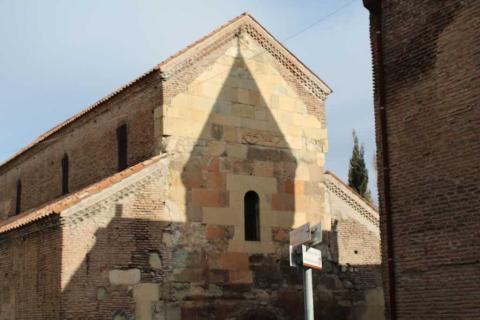Anchiskhati Basilica is one of the oldest (if not the eldest) Georgian Orthodox church's located in Old Town of Tbilisi. The history of this church dates back to the 6 th century AD. Though I have visited it so many times, I haven't yet effectively photographed it. Recently I acquired a new DSLR camera and soon I decided to improve my photographer skills. A walk in Tbilisi is a great both for photo - hobbyists and professional photographers.
Now back on the subject: Anchiskhati Basilica:
Shadow of Anchiskati Bell Tower falling on Basilica
I'm proud of myself that I managed to capture this interesting composition - shadow from bell tower falling on basilica.
Information of Anchiskhati Bell tower
According to written here (Georgian/Russian) - Bell tower of Anchiskhati - characteristic monument to Georgian architecture of late feudalism epoch - according to sources built by Cathotlicos (Patriarch) of Kartli Domentius in 1675.
Icon of Jesus Christ above the entrance in Basilica
Information about Anchiskhati
Again, written in Georgian and English languages
Engraving of Jesus Christ on entrance doors
Inside Anchiskhati Basilica
It was a Palm Sunday according to Georgian Orthodox Church. What's characteristic for Georgian Orthodox church it's rich with many icons which most often are gold-plated, and Anchiskhati Basilica is no exception.
Inside Anchiskhati Basilica
Oh, probably it's not the best photo of inside of Anchiskhati Basilica, but I'm really proud of myself - I managed to take a pretty decent photo in a low light, those gold-plated icons and candles looks amazing.
Prayer candles at Anchiskhati church
Again - either it's me getting better in photography either it just pa decent DSLR camera
Crucifixion of Jesus
Well, what can I add to this - Just one - once in Tbilisi - be sure to visit Anchiskhati church.
About Anchiskhati Basilica
The Anchiskhati Basilica of St Mary is the oldest surviving church in Tbilisi, Georgia. It belongs to the Georgian Orthodox Church and dates from the sixth century.
According to the old Georgian annals, the church was built by the King Dachi of Iberia (circa 522-534) who had made Tbilisi his capital. Originally dedicated to the Virgin Mary, it was renamed Anchiskhati (i.e., icon of Ancha) in 1675 when the treasured icon of the Savior created by the twelfth-century goldsmith Beka Opizari at the Ancha monastery in Klarjeti (in what is now part of northeast Turkey) was moved to Tbilisi so preserve it from an Ottoman invasion. The icon was preserved at the Basilica of St Mary for centuries (it is now on display at the Art Museum of Georgia).
The basilica was damaged and rebuilt on several occasions from the 15th through 17th centuries due to wars between Georgia and the Persians and Turks. The brick belfry near the Anchiskhati Basilica was built by Catholicos Domenti in 1675.
The look of the structure was drastically changed in the 1870s, when a dome was added. During the Soviet period, all religious ceremonies at Anchiskhati Basilica were halted, and the building transformed into a museum for handicrafts. It was later used as an art studio. From 1958 to 1964 restoration works took place in celebration of the 1500th Jubilee of the founding of Tbilisi, which changed the view of the church back to the seventeenth-century version, however, it was not until 1991, after the independence of Georgia was restored, that the basilica reverted to religious use.
The Anchiskhati Choir based out of the Anchiskhati Basilica is the world's leading exponent of Georgian polyphonic choral music.
Anchiskhati Basilica is a three-span basilica, divided by two abutments forming horseshoe shaped conches, which indicates the antiquity of its construction. Originally constructed of blocks of yellow tuff stone, the 1958-1964 restoration made extensive use of brick. The structure has entrances on three sides, but today only the western entrance is in use. Aside from the altarpiece, which was painted in 1683 by order of Catholicos Nikoloz Amilakhvari, all of the remaining paintings in the church date from the 19th century.
